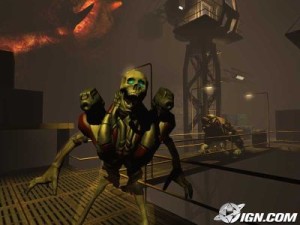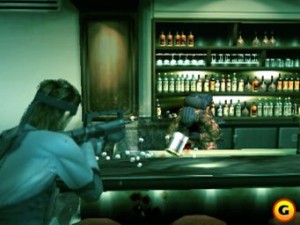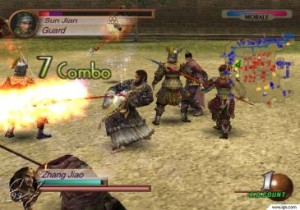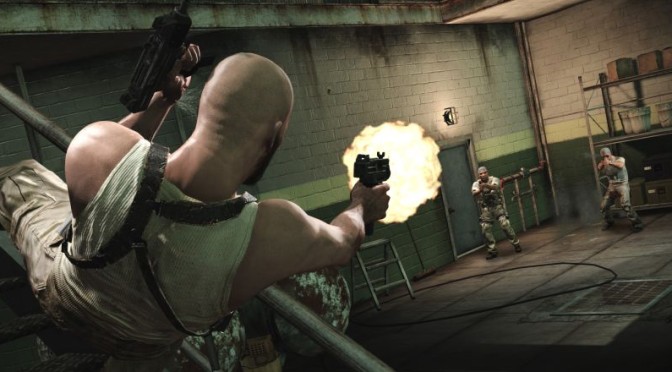There are things that developers grow used to over the years. One of them is the regular appearance of articles that basically say “Make better games!” or “Where’s my next-gen, bitch!?” They generally contain a laundry list of expectations, such as this one:
Where are the FPS bad guys who can adapt their strategy on the fly? Enemies who themselves have six different guns and switch up according to what the situation calls for? Bad guys who work in teams, who strategize, who create diversions to distract you? Where’s the enemy Solid Snake who sneaks up on you with the silence of a ninja’s church fart?
We have seen this argument since the days of Wolfenstein 3D, and it’s our own fault, really… We’re the ones who push the player into more and more realistic places. What should players expect from an incredibly realistic environment, except an incredibly realistic experience?
 Computerized enemies are the most common target. That’s fair… many game enemies can’t even move properly, much less act realistically. But when gamers call for AI opponents that act as realistically and cleverly as a human player, you have to pause and think about what they are saying…
Computerized enemies are the most common target. That’s fair… many game enemies can’t even move properly, much less act realistically. But when gamers call for AI opponents that act as realistically and cleverly as a human player, you have to pause and think about what they are saying…
I mean, come on, how many of you want to be stalked by a ninja that silently sneaks up and slits your throat? To many, that would be like running around and then just randomly falling over dead due to a coronary or something. There are some tempting points in the above excerpt, like bad guys who strategize and all that. This sort of thing is great when it happens, but we have to make sure that we measure each advancement to the fun factor and more importantly, the core values of each game. To take the point to ridiculous extremes, I doubt that Pac-Man would be made better if the ghosts pursued you in 2-by-2 cover formation…
As for military games, how many players really want to feel like they are in a real war? To be cogs in an operation of thousands? To sit in terror that a bullet might come out of nowhere at any moment, striking them dead? Of course not. While gamers want to feel like they are in a “real warâ€, they also want to show off their skills by dispatching enemies and accomplishing important objectives. When they pick up Call of Duty, they want to feel like they “lived WWIIâ€, but they also want to be the powerful, successful, and much-more-important-than-your-average-G.I. protagonist. Players generally do not want to be in a real war, but rather they want to be in a war movie.
 t’s important to remember that games are not just about storytelling or creating a realistic illusion, but they are also about fantasy fulfillment. Consider the source material that fuels the player’s fantasy… an enemy in a typical movie is often poor at being able to shoot the protagonist. He is dangerous in numbers, but he will warn the hero before doing something really deadly. Compare that to the typical hero, who can dispatch dozens of enemies without serious injury. So while players want to believe that the enemies are as deadly as they are, they still expect to be able to kill them en masse. He or she wants to feel potent, effective, and important… everything a fantasy is supposed to deliver.
t’s important to remember that games are not just about storytelling or creating a realistic illusion, but they are also about fantasy fulfillment. Consider the source material that fuels the player’s fantasy… an enemy in a typical movie is often poor at being able to shoot the protagonist. He is dangerous in numbers, but he will warn the hero before doing something really deadly. Compare that to the typical hero, who can dispatch dozens of enemies without serious injury. So while players want to believe that the enemies are as deadly as they are, they still expect to be able to kill them en masse. He or she wants to feel potent, effective, and important… everything a fantasy is supposed to deliver.
A classic target for AI criticism is Metal Gear Solid. Gamers see an enemy that searches doggedly to try to find them, and then after a certain amount of time abandon the search and pretend the player was never there. “That’s unrealistic,†they cry. However, would the game really have been more fun if the enemy cornered him or her into a storeroom and then filled it with poison gas to guarantee the player’s death? Or perhaps the enemy should shut down the entire secret facility at the first sign of intrusion and begin a systematic burn of all areas, creating a “game over†the first time the player is spotted? Much more important than this is our duty to help the player feel crafty and smart.
 Another classic game where battle-lines are drawn is with the Dynasty Warriors series. The player is able to wade through hundreds and hundreds of warriors on a battlefield in an effort to turn the tide of a major battle. Gamers see combat against a single individual as lacking any depth, where they just slash at them a few times and move on. “Look at that unresponsive AI,†they shout. Of course, imagine having to engage in brutal, one-on-one combat with every individual… times a thousand. Or worse yet, these hundreds could use the strength of numbers to simply weigh the player down and skewer him like a trapped pig. Again, this isn’t helping the player feel like “an army of oneâ€, a hero who can survive being outnumbered a hundred to one.
Another classic game where battle-lines are drawn is with the Dynasty Warriors series. The player is able to wade through hundreds and hundreds of warriors on a battlefield in an effort to turn the tide of a major battle. Gamers see combat against a single individual as lacking any depth, where they just slash at them a few times and move on. “Look at that unresponsive AI,†they shout. Of course, imagine having to engage in brutal, one-on-one combat with every individual… times a thousand. Or worse yet, these hundreds could use the strength of numbers to simply weigh the player down and skewer him like a trapped pig. Again, this isn’t helping the player feel like “an army of oneâ€, a hero who can survive being outnumbered a hundred to one.
So, in conclusion, am I suggesting that enemy AI in games will never progress beyond where we are right now? Of course not. There are a hundred ways that game characters can be made to be more interesting, more resourceful, and more satisfying to fight, but that is a discussion for another time. There are also titles such as fighting games that need realistic one-on-one conflict against the most cunning enemies we can devise. Overall, however, it is important for us to understand our job when it comes to making games. Regardless of what players demand, we are here to help them have fun. It is up to us to interpret their fantasies and bring them to life.

